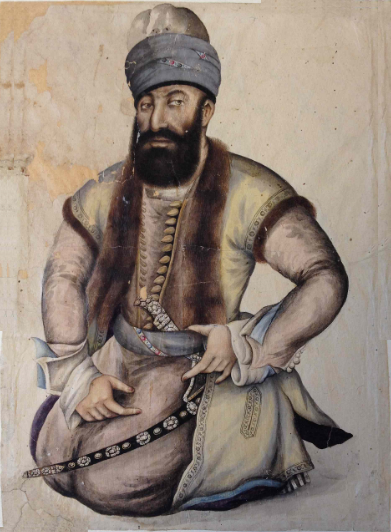Karim Khan Zand

Karim Khan Zand (persisk: کریم خان زند), (ca. 1705–1779) var en iransk hersker af kurdisk eller lur herkomst, som var grundlægger af Zand-dynastiet, som styrede Iran, Irak, Aserbajdsjan, Armenien, Georgia og dele af Tyrkiet og Rusland.[kilde mangler]
Karim Khan var en af Nader Shahs soldater. Efter Nader Shahs død i 1747 havnede Iran i en borgerkrig. Karim Khan, Abol-Fath Khan Bakhtiari og Ali Mardan Khan Bakhtiari indgik en aftale om at dele landet mellem sig og give tronen til Safavide prinsen Ismail III. Men samarbejdet endte, efter Ali Mardan Khan invaderede Isfahan og dræbte Abol-Fath Khan. Karim Khan dræbte derefter Ali Mardan Khan og erobrede hele Iran med undtagelse af Khorasan af respekt for Shahrokh Shah, som var Nader Shahs barnebarn. Karim Khan nægtede at tage titlen konge, og i stedet kaldte han sig for Vakil-e Ra'aya (folkets regent).
Under hans styre blev relationer med Storbritannien genoptaget: Han han tillod det britiske Ostindiske kompagni en handelsstation i det sydlige Iran. Han gjorde Shiraz til sin hovedstad og beordrede en arkitektonisk genoprustning. Efter hans død brød borgerkrigen ud igen, og ingen af hans efterkommere formåede at regere landet så effektivt som han, før Agha Mohammed Khan fra Qajar-dynastiet kom til magten.
Kilder
[redigér | rediger kildetekst]- Fisher, William Bayne; Avery, P.; Hambly, G. R. G; Melville, C. (1991). The Cambridge History of Iran. Vol. 7. Cambridge: Cambridge University Press. ISBN 0521200954.
- Perry, John R. (2011). "Karim Khan Zand". Encyclopaedia Iranica, Vol. XV, Fasc. 6. s. 561-564.
- Perry, John R. (2010). "Zand dynasty". Encyclopaedia Iranica, Vol. XV, Fasc. 6.
- Perry, John R., Karīm Khān Zand: a history of Iran, 1747–1779 University of Chicago Press, 1979, ISBN 978-0-226-66098-1 and One World Publications, 2006 ISBN 978-1-85168-435-9.
- Malcolm, John, Sir, The history of Persia, from the most early period to the present time containing an account of the religion, government, usages, and character of the inhabitants of that kingdom in 2 volumes; London : Murray, 1815.; re-published by Adamant Media Corporation 2004 vol 1. ISBN 978-1-4021-5134-7; vol. 2 ISBN 978-1-4021-5205-4.
- Perry, J. R. (1984). ĀḠĀ MOḤAMMAD KHAN QĀJĀR. Encyclopaedia Iranica. Vol. I, Fasc. 6. s. 602-605.
- Hambly, Gavin R.G (1991). "Agha Muhammad Khan and the establishment of the Qajar dynasty". The Cambridge History of Iran, Vol. 7: From Nadir Shah to the Islamic Republic. Cambridge: Cambridge University Press. s. 104-144. ISBN 9780521200950.
- Perry, John (1991). "The Zand dynasty". The Cambridge History of Iran, Vol. 7: From Nadir Shah to the Islamic Republic. Cambridge: Cambridge University Press. s. 63-104. ISBN 9780521200950.
- Bakhash, S. (1983). "ADMINISTRATION in Iran vi. Safavid, Zand, and Qajar periods ". Encyclopaedia Iranica, Vol. I, Fasc. 5. s. 462-466.
{{cite encyclopedia}}: Ekstern henvisning i|article= - Garthwaite, Gene R. (2005). The Persians. Wiley. s. 1-311. ISBN 9781557868602.
- Shaw, Stanford (1991). "Iranian relations with the Ottoman Empire in the eighteenth and nineteenth centuries". The Cambridge History of Iran, Vol. 7: From Nadir Shah to the Islamic Republic. Cambridge: Cambridge University Press. s. 297-314. ISBN 9780521200950.
| Spire Denne artikel om en kongelig eller fyrstelig person er en spire som bør udbygges. Du er velkommen til at hjælpe Wikipedia ved at udvide den. |